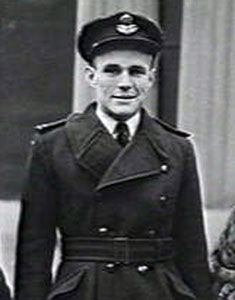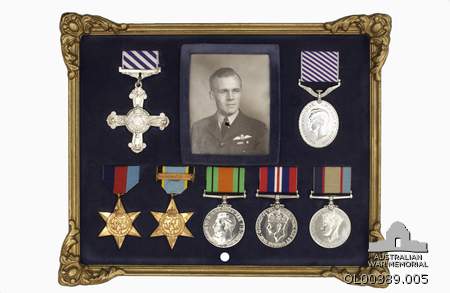During the evening of 17th December 1942 the crew of this 460 Squadron aircraft were tasked with a mine laying flight off Denmark. They left base at 16.50hrs and with the weather poor in the area the mines were to be dropped the pilot opted to abandon the flight so returned home with the mines. The aircraft was struck by flak in the starboard wing during this operational flight and a eight inch hole was found in the wing upon landing at 23.00hrs.
Pilot - Sgt James Alexander Saint-Smith RAAF (403380), Earlwood, New South Wales, Australia.
Navigator - F/Sgt Geoffrey Ernest Heath RAAF (Aus/6025), of Croydon, New South Wales, Australia.
Bomb Aimer? - Sgt Philip William Ward RAAF (402626), of Denman, New South Wales, Australia.
Flight Engineer - Sgt H Perkins RAF.
Wireless Operator / Air Gunner - F/Sgt R A Wildman RAAF.
Air Gunner - Sgt H T Wilson RAAF.
Air Gunner - Sgt J F Ward RAAF.
Lancaster W4783 was built to contract B.69275/40 by Metropolitan-Vickers Ltd. at Trafford Park, Manchester and was awaiting collection in October 1942. It was taken on charge by 460 Squadron at Breighton on 22nd October 1942. As a result of the damage sustained on 17th December 1942 minor Cat.Ac/FB damage was the assessment and it was repaired on site at Breighton. It was slightly damaged by flak on 17th January 1943 and was repaired on site. Cat.A/Fb damage was the probably assessment. On 14th April 1943 it sustained further Cat.A/FB damage when the cockpit windscreen was shattered, possibly after being hit by falling bombs from above. Again it was repaired on site and moved with 460 Squadrnon to Binbrook on 14th May 1943. These damage incidents do not feature on the aircraft's AM.78 movement card. It is listed as have sustained Cat.Ac/FA damage on 3rd July 1943 that was repaired on site. In May 1944 it was sent to A.V.Roe for a repair in works and probably a full service. In October 1944 it was transferred to the RAAF and re-serialled 'A66-2'. On 11th October 1944 it commenced the long flight to Australia and arrived in Brisbane on 8th November 1944. Once there the next day it was flown to No.3 Aircraft Depot at Amberley. Between late 1944 and July 1945 it was used on a fund raising tour of Australia. In July 1945 it was flown into outside storage at RAAF Fairbairn, Canberra. In the early 1950's a decision was made to preserve the aircraft and work commenced to prepare it for display. It is still housed at Canberra A.W.M. where it can be seen today.
F/O Saint-Smith and F/O Heath were sadly killed on 29th June 1944 on Ops to bomb a V-1 launch site near Beauvoir, France, it was believed that the 627 Squadron aircraft, Mosquito DZ516, was probably caught in the blast of a V-1 that prematurely exploded near the Mosquito. The aircraft crashed near the village of Vaulx, near Tournai, Belgium and both men were initially buried in the local village cemetery. This was F/O Saint-Smith's seventy third operational flight. Post-War the Wargraves investigation unit exhumed their bodies and they were later re-buried in a joint grave in Abbeville Communal Cemetery, France. Both men were twenty six years old.

James Saint-Smith was born on 29th December 1917 in Singleton, New South Wales. He enlisted on 6th January 1941 in Sydney and was working as a school teacher at the time. He gained his Wings on 1st September 1941 in Canada. On arrival in the UK he was posted to 23 OTU on 21st October 1941 and later to 12 Squadron on 16th March 1942 flying Wellingtons. This posting was only brief as he was soon posted to 460 Squadron on 11th May 1942, he flew Wellingtons with this unit until converting to the four-engined heavies at 460 Squadron Conversion Flight on 20th August 1942 before returning to his parent unit. He was later posted to 1656 HCU on 21st October 1942 and again returned to 460 Squadron on 10th November 1942. He and his crew were Lancaster W4783's first pilot/crew, this aircraft is preserved in Canberra, Australia. He flew it on thirteen operational flights with 460 Squadron. He was awarded the DFM for service with 460 Squadron for completing his Tour, his DFM was Gazetted on 14th May 1943, the citation reads.. "F/Sgt Saint-Smith has displayed outstanding determination in pressing home his attacks on enemy targets during numerous operational sorties. Early in March 1943 he participated in a raid on Berlin and obtained an excellent photograph after the bombs had been released. He has at all times taken great care to identify the target and has, as pilot, done all in his power to ensure accurate bombing. His high courage, skill and initiative have set a magnificent example to his crew."

Having completed his first Tour he was posted to instruct on 29th April 1943. He was later posted to 1655 MTU for Mosquito training on 23rd November 1943. He then took a posting to 627 Squadron PFF on 23rd December 1943. He had received commission on 17th February 1943 to the rank of P/O and was promoted to F/O on 18th August 1943. He was recommended for the DFC for service with 627 Squadron (later Gazetted on 15th August 1944), this was infact granted after his death and the reasons behind his loss are given below. The citation for his DFC reads.. "F/O Saint-Smith has taken part in a number of major attacks on Germany and enemy occupied territory. He has taken an important part in attacking an aircraft factory near Oslo and in several other operations against targets in Germany and France exerting himself to the utmost to ensure their complete and final success. All these operations have had to be accomplished from a low level and have owed much of their effectiveness to his conspicious gallantry and determination."
Geoffrey Heath was born in Croyden, New South Wales on 27th December 1917 and enlisted in Richmond, New South Wales on 30th October 1939. He was awarded his Air Observers Badge on 18th August 1941. On arrival in the UK he was posted to 14 OTU on 14th October 1941 before arriving at 12 Squadron on 7th March 1942 where presumably he met with James Saint-Smith who was posted to 12 Squadron a week later. He became James Saint-Smith's regular navigator and he too was posted to 460 Squadron on 11th May 1942 and converted to the four-engined heavies at the same time as his pilot, he was later posted to 1656 HCU and returned to 460 Squadron on the same dates as his pilot (as shown above). Having completed his Tour he too was awarded the DFM for his service to 460 Squadron, Gazetted on the same date as Saint-Smith: 14th May 1943. The citation reads.. "As a N.C.O. Pilot Officer Heath took part in many successful sorties including a raid on Milan and three on Berlin. His last sortie was against Berlin on 1st March 1943. He has displayed great skill often in difficult circumstances, which has played a large part in the successes obtained. Cool and resourceful in an emergency, he has proved himself to be a valuable member of the aircraft crew."
He had received a commission on 15th January 1943 to the rank of P/O and was promoted to F/O on 15th July 1943. Having been posted to 27 OTU on 19th April 1943 to act as a navigation instructor he was flying in Wellington BJ713 on 6th July 1943 which crashed soon after taking off from Church Broughton airfield. He injured his left leg and was admitted to Derby hospital. Both Heath and Saint-Smith were re-united as a pair and were posted to 1655 MTU together on 23rd November 1943 and later to 627 Squadron PFF on 24th December 1944. Heath was recommended for the DFC for service with 627 Squadron (later Gazetted on 15th August 1944), this was infact granted after his death and the reasons behind his loss are given below. The citation for his DFC reads.. "As navigator, F/O Heath has flown on many long distance sorties. The targets have been varied and in many cases difficult to locate but his navigational skill, together with his great determination have invariably located the exact position. The success of many of these attacks can largely be attributed to this officer's initiative and co-operation."
Geoffrey Heath had met a North Duffield girl while stationed at Breighton with 460 Squadron and married her in either 1943 or 1944. She later re-married and moved to Vancouver, Canada.
Phillip Ward was born on 7th April 1922 in Sydney, he enlisted in Sydney and was awarded the DFC for service with 460 Squadron on 17th August 1943. No citation has been located. He survived the War.
Nothing more is currently known about the other members of the crew listed above.